|
History
of Tustin

Tustin
is a city that is proud of its small-town heritage.
Although it is growing in population, city officials
and residents want to hold on to the city's old-fashioned
atmosphere.
The
story of Tustin begins with the land itself. It
is situated on the floodplain of the Santa Ana
River and its tributary, Santiago Creek, south
and west of the Santa Ana Mountains. The most
prominent landmark in the Tustin area is a hill
known as "Red Hill" which is 347 feet high. The
soil on Red Hill turned red when ancient volcanic
activity deposited cinnabarite (mercury) in the
sandstone hill. The Native Americans than inhabited
the Tustin area prior to the Spaniards called
the hill "Katuktu" defined as "Hill of Prominence"
or "Place of Refuge".
Tustin
was founded in 1868 by Columbus Tustin, a Philadelphia
farmer and entrepreneur. But the town's growth
was rather slow compared with neighboring Santa
Ana and Orange. It took nearly 60 years before
the predominantly farming community grew to 500
residents and incorporated.
In
the early days, what was then called "Tustin
City" lived in the shadows of Santa Ana.
But many Tustin residents did not seem to mind.
They
cherished their citrus and eucalyptus trees, the
view of nearby hills and the small-town atmosphere.
 The
trees eventually gave
way to
development as houses, shops and industrial sites
sprang up. In 1942, the US Navy
established a base for use of blimps for antisubmarine
patrols. The US Marine Corps took over the base
in 1951, and until it's recent closure, was used
as a helicopter air station. The
trees eventually gave
way to
development as houses, shops and industrial sites
sprang up. In 1942, the US Navy
established a base for use of blimps for antisubmarine
patrols. The US Marine Corps took over the base
in 1951, and until it's recent closure, was used
as a helicopter air station.
The
Tustin Historical Society looks for artifacts
from the city's pioneer days and the city is continuously
working to preserve old buildings through strict
laws regulation demolition of historic structures.
Old
Town, which is defined by the original boundaries
of the city when it incorporated in 1927, is home
to several historic structures, including the
Knights of Pythias building that housed Tustin's
first City Hall. The Tustin Area Museum is located
on El Camino Real in historic downtown Tustin.
The museum carries an extensive collection of
artifacts, books and photos from Tustin's early
days.
Although
most citrus orchards have been replaced by homes,
schools, shopping centers and industry, there
remains a vast and varied assortment of eucalyptus,
pepper, palm, pine and oak trees throughout the
City. As in the beginning, Tustin continues to
be the "City of Trees".
Historical
Sites:
Hewes
Mansion - 350 S. B Street
The 14-room Victorian mansion was built in 1881
by prominent California pioneer David Hewes. The
area superintendent of schools and some teachers
lived there at one time; it is said that a count
also once lived in the mansion. It is not open
to the public.
Red
Hill - Browning and La Colina avenues
Indians called it "place of refuge;"
the Spanish called it "Hill of Frogs."
This summit was the boundary for three ranchos.
Cinnabar was mined there in the late 1800s; mercury
gives the soil its reddish color. Houses now occupy
the site.
|


![]()



